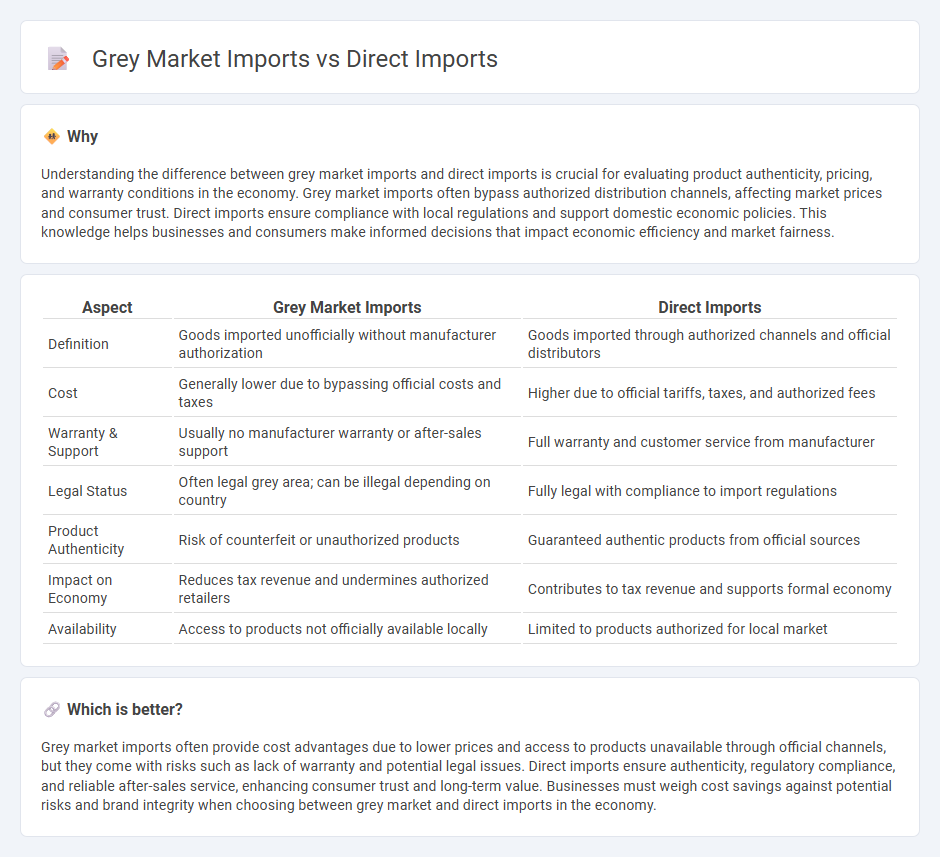
Grey market imports refer to goods brought into a country through unauthorized channels, often bypassing official distribution networks, leading to potential regulatory and warranty issues. Direct imports involve purchasing products straight from foreign manufacturers or authorized distributors, ensuring compliance with legal standards and quality assurances. Explore further to understand the economic impacts and risks associated with both import methods.
Why it is important
Understanding the difference between grey market imports and direct imports is crucial for evaluating product authenticity, pricing, and warranty conditions in the economy. Grey market imports often bypass authorized distribution channels, affecting market prices and consumer trust. Direct imports ensure compliance with local regulations and support domestic economic policies. This knowledge helps businesses and consumers make informed decisions that impact economic efficiency and market fairness.
Comparison Table
| Aspect | Grey Market Imports | Direct Imports |
|---|---|---|
| Definition | Goods imported unofficially without manufacturer authorization | Goods imported through authorized channels and official distributors |
| Cost | Generally lower due to bypassing official costs and taxes | Higher due to official tariffs, taxes, and authorized fees |
| Warranty & Support | Usually no manufacturer warranty or after-sales support | Full warranty and customer service from manufacturer |
| Legal Status | Often legal grey area; can be illegal depending on country | Fully legal with compliance to import regulations |
| Product Authenticity | Risk of counterfeit or unauthorized products | Guaranteed authentic products from official sources |
| Impact on Economy | Reduces tax revenue and undermines authorized retailers | Contributes to tax revenue and supports formal economy |
| Availability | Access to products not officially available locally | Limited to products authorized for local market |
Which is better?
Grey market imports often provide cost advantages due to lower prices and access to products unavailable through official channels, but they come with risks such as lack of warranty and potential legal issues. Direct imports ensure authenticity, regulatory compliance, and reliable after-sales service, enhancing consumer trust and long-term value. Businesses must weigh cost savings against potential risks and brand integrity when choosing between grey market and direct imports in the economy.
Connection
Grey market imports and direct imports are connected through their impact on the economy by influencing supply chain dynamics and market pricing. Grey market imports bypass authorized distribution channels, often lowering product costs and affecting official importers, while direct imports involve purchasing goods directly from foreign manufacturers, potentially reducing costs and increasing competitiveness. Both import methods shape trade policies, consumer behavior, and the overall market equilibrium in domestic economies.
Key Terms
Authorized Distribution
Authorized distribution ensures products are sourced directly from manufacturers, guaranteeing authenticity, warranty support, and compliance with regional regulations. Grey market imports bypass official channels, often resulting in products without warranty, potential counterfeit risks, and limited after-sales service. Explore the critical differences between direct and grey market imports to make informed purchasing decisions.
Parallel Trade
Direct imports ensure products are sourced through authorized channels, maintaining brand warranty and consistent quality standards. Grey market imports, or parallel trade, involve goods imported outside official distribution networks, often resulting in lower prices but potential warranty and compatibility issues. Discover the impact of parallel trade on pricing, consumer rights, and market regulation by exploring detailed insights.
Tariffs
Direct imports face standard tariffs set by the destination country's customs authority, ensuring compliance with legal trade regulations and predictable duties. Grey market imports often encounter higher or unexpected tariffs because they bypass official distribution channels, potentially leading to seizures or fines. Explore how tariff differences impact pricing and legality in international trade by learning more about direct versus grey market imports.
Source and External Links
Importer of Record vs Direct Import - Which is Right for Your Business? - Direct imports involve the buyer and seller directly handling all aspects of the import transaction without intermediaries, offering greater control, higher profit margins, and the opportunity to build import expertise, mostly suited for enterprise businesses.
DIRECT IMPORT definition | Cambridge English Dictionary - Direct import refers to a company purchasing products directly from another country without involving any third party or agent in the arrangement.
12.050 Direct Import Vehicles - California DMV - CA.gov - In the context of vehicles, direct imports are those manufactured for use in other countries and imported directly, requiring special registration and compliance with U.S. safety and environmental standards to be legally registered.
 dowidth.com
dowidth.com